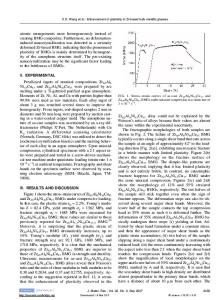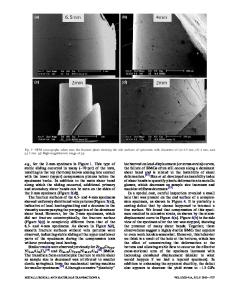Synergistic effect of crystalline metal on the plasticity of bulk metallic glasses under uniaxial synchro-compression
- PDF / 1,522,520 Bytes
- 9 Pages / 584.957 x 782.986 pts Page_size
- 102 Downloads / 296 Views
iaxial synchro-compression test of a cylindrical bulk metallic glass (BMG) specimen along with a crystalline metallic ring having an inner diameter much larger than the specimen’s diameter and thereby without radial confinement on the BMG specimen was performed. The plastic deformation behavior of a conventional Zr65Cu17.5Ni10Al7.5 BMG under synchro-compression with a cupper ring was investigated. It was found that remarkably plastic deformation in the inherently brittle BMG could occur under the uniaxial stress state as the loading area of the cupper ring was sufficiently large, and multiplication of the shear band on the synergistically deformed BMG specimen could be accomplished. The synergistic effect of the crystalline metal on the plastic deformation behavior of the BMG was attributed to the reduced thermal softening extent inside the shear bands that resulted from the restraining effect of the copper ring on the spring-back action of the testing machine. I. INTRODUCTION
Bulk metallic glasses (BMGs), which have some attractive mechanical properties such as high yield strength and elasticity, have been regarded as potential candidates for new structural and functional applications.1 However, BMG room-temperature brittleness is still one of the most serious problems that limits their real engineering applications.2 Therefore, how to improve the plasticity of BMGs has become one of the hottest topics in recent years.3 The adoptable ways and means to ductilize BMGs depend on the correct understanding of the plastic deformation mechanism. Shear band formation by initiation and propagation is the expected plastic deformation mode in BMGs at temperatures well below the glass transition.4–6 The initiation of shear bands in BMGs is a structural softening of the materials caused by shear dilatation,6 but the propagation of the bands is leadingly affected by the thermal softening of the materials due to rapidly rising local temperature inside the bands.7,8 Ever since the first observations of the BMGs’ shear fractographs with the viscous flow features of vein-like and river-like patterns, high temperature bursts and associated viscosity drops inside shear bands have received much attention. Although the exact degree range of the temperature rise remains controversial, the rapid local heating phenomenon is widely accepted. Local heating plays a significant role in the propagation a)
Address all correspondence to this author. e-mail: [email protected] DOI: 10.1557/JMR.2009.0367 J. Mater. Res., Vol. 24, No. 10, Oct 2009
of shear bands.6 Under the uniaxial loading condition, if the propagation of shear bands cannot be arrested, BMGs will catastrophically fracture along one dominant shear band and show highly localized deformation behavior even at a quasi-static strain rate. Although the strain in an individual shear band could be extremely high,9,10 BMGs usually exhibited very low global plasticity because of limited shear band quantity. It appears that the shear-banding deformation mode does not change until the micr
Data Loading...











